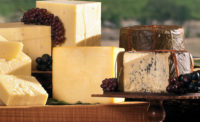Consumers are eating cheese more than ever – especially at home where cheese consumption has been on the rise over the last 30 years. Considering that home is the source of 80% of our meals and that cheese adds appeal to a wide variety of dishes, the cheese category becomes an even more important consideration for retailers. To help understand retail cheese trends and ways to best market cheese to customers, Wisconsin Milk Marketing Board has analyzed four areas to take note of in 2014.
Flavored cheese trending upwards
It has been said that variety is the spice of life, and when it comes to cheese, consumers are hungry for spicy flavors and can find lots of options in the cheese case. These include chipotle, habanero, horseradish, Cajun, jalapeño and black pepper.
There is also conspicuous growth in sweet, savory and herb- and nut-flavored cheeses such as cinnamon, caramel, maple, caraway and dill. In total, flavored cheeses at grocery retail have enjoyed a volume sales lift of approximately 2% compared to the total cheese category, which has been relatively steady in sales over the past year, according to research firm IRI, Chicago.
The growth in specialty cheese consumption by consumers has helped fuel the increase in flavored cheese usage, as well. Whether aged, ethnically influenced or enhanced with sweet, nutty or spicy flavors, specialty cheeses offer opportunity for expanding the appeal of a product that’s enjoying growing popularity.
Innovative packaging is based on consumers’ needs
Cheese companies are continually innovating their packaging to offer increased sustainability, portability and optimal freshness. With U.S. households becoming smaller, there is an increased variety of smaller package options. These smaller packages appeal to the consumer on two fronts: price and perishability.
Consumers can spend less on a smaller package and are more likely to use it all. Smaller, less expensive sizing also appeals to consumers who want to try a new cheese before buying a larger amount. Moreover, consumers desire packaging that is convenient and keeps cheese fresh.
Shredded and sliced cheese cuts, two of the most popular forms of cheese, feature popular packaging styles, including re-sealable bags and new stand-up bags for shreds. Clear cups for grated and crumbled cheeses, shreds and balls are popular. For on-the-go or in-the-lunchbox, the packaging includes individually wrapped sticks, slices and more.
Packaging trends also reflects consumers’ widespread desire for more information about product details, such as origin, usage and pairing suggestions and nutrition. Increasingly, packaging is becoming environment friendly and biodegradable.
When Americans eat cheese
The number of times consumers eat cheese is trending up in all occasions over the past five years, with breakfast and lunch seeing the largest gains. Snacking occasions for cheese are also increasing. Today, overall snacking accounts for about 21% of American’s daily eating. Because snack foods tend to be convenient and handy, they are increasingly in demand as main meals or as part of a main meal, according to NPD, a marketing research firm.
Snacking is a natural fit for cheese – it’s easy to enjoy, can be hand-held and needs no further cooking, warming or preparation. Enhancing the appeal, companies offer cheese in portable packaging. “Premium Snacking” is also a category that is expected to see growth. Premium cheeses are beginning to be available in small, individual packages, satisfying consumers’ desires for easy, flavorful foods and meal replacement options.
In home usage, cheese is used as an ingredient (including as a topping, flavor enhancer or added on or in a dish) 92% of the time. The six most popular consumer cheese applications are sandwiches, cheese as cheese, Italian dishes, Mexican dishes, salads and eggs.
Americans are continuing the trend of eating more natural cheese than processed cheese. Natural cheese now accounts for approximately 74% of retail cheese sales as it is edging out processed cheese in previously dominated categories, such as sandwiches. While the forecast for natural cheese predicts continued growth, processed cheese is still quite popular, accounting for about 26% of grocery sales in the United States, IRI reports.
In foodservice, some of the fastest growing cheese varieties on breakfast menus are Gouda, Queso, Provolone and ricotta, according to Technomic, a restaurant analyst in Chicago. Among the fastest growing are Oaxaca, Chihuahua, Jalapeno and Asadero. The expansion of Hispanic cheeses on menus reflects the rise in the overall popularity of Hispanic-style foods.
A need for private label cheeses
While retailers continue to calendar successful promotions at holiday and special event times, the style is changing. Increasingly, stores and chains desire promotions that reflect their unique identities and offerings. This desire for differentiation is seen in the increasing number of stores that have developed their own private label selections and promotions as well as promotions such as Wisconsin Milk Marketing Board’s “Toolbox” promotions.
WMMB and the retailer work together to customize content of these promotions. We include store name, logo, brands and Wisconsin cheeses that the retailer currently markets. We use in-store collateral and signage, media communications and recipe brochures. Additionally, optional in-store cheesemaker visits are often part of these programs. In the year ending in June 2013, more than 1,600 Wisconsin cheese promotions were conducted throughout the country.








